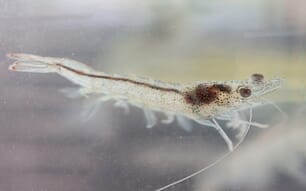The warning of the Vietnam Association of Seafood Exporters and Producers (VASEP) follows a decision taken by a Japanese watchdog last month to increase inspection of items from 30 per cent to 100 per cent on shrimp imported from Viet Nam. It found that seafood products imported from Viet Nam contained trifluralin residues that exceeded the allowed limit of 1 microgram per kilogram.
Trifluralin, a commonly used pre-sowing herbicide used to control grasses and broad-leaf weeds, is said to be a harmful substance that can cause cancer.
Local exporters should be strict and double-check raw materials supplied by farmers to ensure that harmful substances are removed before processing them, said the associations secretary general Truong Dinh Hoe.
Mr Hoe told Thanh Nien Weekly that 100 per cent inspection has increased time and cost of preparing shipments, and raised the threat of similar happenings in other export markets.
He asserted that there is no evidence that trifluralin causes cancer as alleged by the watchdog.
Last year, European authorities had warned exporters about the toxic residue exceeding permitted volumes in shrimp exported to the bloc, but they have not imposed the measure yet.
Ngo Van Nga, CEO of the Quoc Viet seafood processing company in Ca Mau Province, said local firms used no trifluralin in the processing of seafood products but it was not easy for them to detect the substance at microgram (equal to a millionth of one gram) levels even with the most modern testing equipments.
Japan had imposed another inspection on Vietnamese shrimp 10 years ago after finding excess amounts of chloramphenicol residue, also said to be carcinogenic.
Japan is Viet Nams biggest shrimp buyer, accounting for about 30 per cent of the countrys total shrimp exports a year.
The Ministry of Agriculture and Rural Development banned the use of trifluralin in fisheries this April, but Vietnamese farmers continued to use the substance to kill unwanted parasites in shrimp farming.
Tran Thien Hai, chairman of the association, blamed the governments policy that allows the import of toxic substances like trifluralin, even going to the extent of saying there could be some foul play involved.
There is no evidence of unfair practice, but we have our suspicious, said Mr Hai, who added chloramphenicol, the other substance that has caused difficulties for Vietnamese fisheries, was also an imported product, from China.
The chairman said someone in government agencies was responsible for causing difficulties for local exporters by permitting the import of toxic substances.
The association was studying the issue and considering a lawsuit against government agencies responsible for such a decision affecting local fisheries, Hai said in a meeting held by the association last week.
Ho Quoc Luc, head of the associations Shrimp Commission, said trifluralin was banned in fisheries, but it is still used by farmers to kill unwanted plants.
The ministrys National AgroForestry Fisheries Quality Assurance Department said 38 products containing trifluralin imported from Thailand were still in use.
Mr Luc said the government should soon eliminate the substance from its list of importables.
Dinh Chi Trung, assistant manager of Japanese firm Sojitzs Food Resources Department, said the 100 per cent inspection decision has worried both importers and consumers in Japan.
Mr Trung told the news agency that the number of shipments to Japan has reduced from around 10 containers to one or two containers a month.
He said the Vietnamese government should act firmly to solve the issue, especially in shrimp farming, or the countrys exports of the crustaceans to Japan would grind to a standstill.
Viet Nam exported 167,000 tons of shrimp worth US$1.4 billion, an increase of 22 per cent in value, in the first nine months of 2010.
VASEP said Japan imported 45,500 tons of shrimp worth $412 million during this period.
The US and Europe are also big importers of Vietnamese shrimp, with imports reaching $376 million and $225 million respectively from January to September.
Toxic Residues Could Shrivel Shrimp Exports
VIET NAM - Processors have to be very careful to ensure there are no toxic residues in their seafood shipments, or the nation will face bans imposed by governments in export markets, an industry group has warned.




